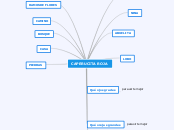Especies Representativas de la Región Costa
Identify how rainforest animals have adapted to live in this unique environment.
Rainforests in Central America, Amazon, Asia, Africa, and Australia cover about 6% of our earth's surface, but they are the home ground for more than half of the species of animals in the world.
6. MANGLARES
Los manglares están presentes a lo largo de la costa de las provincias de Esmeraldas, Manabí, Guayas y El Oro
5. TIERRAS BAJAS DE LA COSTA
El sotobosque es denso y está compuesto por varias especies de Rubiaceae y palmas pequeñas, especialmente Geonoma.
Están dominados por especies arbóreas de las familias Myristicaceae, Moraceae, Fabaceae y Meliaceae.
4. BOSQUE PIEMONTANO OCCIDENTAL
Las palmas y árboles de las familias Mimosaceae, Fabaceae y Burseraceae son dominantes.
The Koala
is a marsupial often mistaken for a bear due to its large and furry stout body.
familia Mimosaceae
What traits did the Koala develop
to adjust to its habitat? Type in the answers.
Example: to survive the occasional flooding in its environment, the koala has developed the instincts of swimming and jumping from tree to tree.
Se encuentra en las provincias de Esmeraldas, Carchi, Imbabura y Pichincha.
The Rainbow Lorikeet
is the most strikingly colored bird of the over 300 parrot species found in SW Pacific.
Fabaceae
What traits did the Rainbow Lorikeet develop
in order to adapt to the rainforest environment? Type in the answers.
Example: has adapted feet - two toes in front and two behind - that help it sit atop of trees.
3. BOSQUE HÚMEDO TROPICAL DEL CHOCÓ
La degradación antropogénica del hábitat en esta región es una de las más altas en el Ecuador; casi el 75% del bosque ha sido destruido por actividades humanas.
The Black Colobus Monkey
is among the most endangered primate species in Africa.
Palmas, sande, guabas, roble, guarumo, canelo y la balsa
What traits did the Black Colobus develop
in order to adjust to its habitat? Type in the answers.
Example: it has no thumbs since it has to leap through the forest habitat, and the chances of thumb injuries are very high.
Es la segunda región natural más grande del Ecuador con 31 732 km2.
The Madagascar Hissing Cockroach
has become famous because of its bizarre way of producing sounds. This cockroach makes a hissing sound by pushing air through tiny holes in its body.
Plantas y palmeras
What characteristics did this coackroach develop
in order to adjust to the environment it is living in? Type in the answers.
Example: it is dark-colored, which makes its camouflage with the dirt and leaves a whole lot easier.
2. BOSQUE DECIDUO DE LA COSTA
Algunas especies de árboles pierden sus hojas durante la época seca.
Son bosques muy frágiles y soportan fuertes presiones antrópicas.
The Silvery Gibbon
can only be found on the island of Java, Indonesia. Due to their isolated location, it is estimated that less than 2000 Silvery Gibbons are currently living in their natural habitat.
Jatropha curcas “piñón” (Euphorbiaceae).
What characteristics did the gibbon develop to adjust to its environment?
Example: The Silvery Gibbon has long arms that help it swing easily through the branches.
La mayoría de especies arbóreas pierden el follaje en la temporada seca.
The Indian Cobra
is the world's most lethal species of cobra. It lives in the forests of India, Pakistan, Nepal, Sri Lanka, Bhutan and Bangladesh.
Tectona grandis “teca” (Verbenaceae)
What characteristics did the Indian Cobra develop?
Type in the traits that this animal developed in order to adapt to its habitat.
Example: it has patterned, circular lines on the back which creates an optical illusion. This way, it becomes more difficult to spot the Indian Cobra in its natural habitat.
1. MATORRAL SECO DE LA COSTA
Clima cálido seco
The Sloth
is an extremely slow-moving mammal found in the rainforests of Central and South America.
"Caña guadúa” (Poaceae)
What characteristics did the sloth develop in order to adjust to the environment it is living in? Type in the answers.
Example: it has huge, hooked claws and strong, long arms that allow it to hang upside-down from trees.
Cubre un área de 8033 km2
The Toucan
is one of the most important species in the rainforest because it spreads the seeds of the fruits and plants that it eats, therefore contributing to plant biodiversity.
Characteristics
CACTUS(Strophocactus testudos)
What characteristics did the toucan develop while trying to adapt to this unique environment? Type in as many characteristics as you can find.
Example: Sharp, saw-like bill that helps it crack the nuts, berries and other fruits that it eats.









